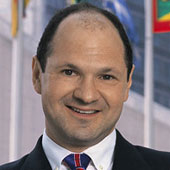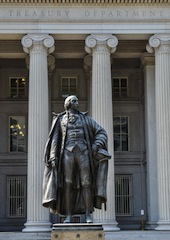Wall Street Wants the Fed to Save it From Itself
When BlackRock talks, people should be listening.
October 31, 2013

When it comes to financial bubbles, Joe Q. Public tends to find out about them from the nightly news and not from his financial advisor. Most of the time, the discovery comes too late, after his pension fund, his children’s college account and other savings have lost half of their value in a spectacular market crash.
That’s because financial advisors have a bullish bias. Their job is to sell financial assets. Warning clients about emerging financial bubbles – and their eventual catastrophic bursting – doesn’t make for a good sales pitch.
But this time is different. Several investment banks have been warning that the stock market has become dangerously overvalued. Laurence Fink, the head of BlackRock, the large asset management firm, declared recently that Wall Street has reached “bubble-like conditions”.
Indeed, the Dow Jones Industrial Average and the broader S&P 500 index are in record territory. Even the NASDAQ Composite index of technology shares is at its highest level since the bursting of the dot.com bubble in March 2000.
Fink called on the U.S. Federal Reserve to tighten its monetary policy. BlackRock is the world’s largest money management firm with over $4 trillion of assets under management (equal to about a quarter of America’s annual GDP).
When BlackRock talks, people should be listening – except the Fed didn’t, declaring that the economy is too weak and vowing to continue pumping liquidity into the financial system. Extreme monetary ease is now in its sixth year.
The source of the problem
The irony is that the financial industry’s big players are themselves responsible for the bubble they are now sounding the alarm on. They believe in the so-called “Bernanke put.”
That phrase captures the views that the Fed will continue its highly accommodative monetary policy as long as the U.S. labor market remains weak and the economy creates only around 150,000 jobs per month. That is considerably below the 300,000-plus jobs created per month typical of previous postwar recoveries.
The Fed, under its current quantitative easing program, puts $85 billion in new liquidity into the banking system every month. People on Wall Street know that, as long as the monetary spigot remains wide-open, stock prices will continue to rise. And so banks keep channeling that $85 billion into stocks – and stock prices indeed continue to rise.
So far so good. Everybody makes money – at least for now. Why is this worrying banks and large money managers such as BlackRock?
Canary in the coal mine
Because the small investor has now bought into the bull market idea as well. Following the 2008 financial crisis, small investors stayed clear of the stock market, preferring instead to pay down their debts. Joe Q. Public was spooked by catastrophic stock market debacles that kept wiping out his savings with depressing regularity.
But now mutual funds that invest in stocks have been seeing huge inflows from smaller investors. So far in 2013, such funds received $277 billion of new money. Small investors are once again hoping that the stock market rally will go on for a while and that they will finally get rich.
However, the moment the average investor starts believing the hype is, effectively, the canary in the coal mine moment. By the time the small investors throw caution to the wind and invest in the stock market, a bubble is definitely forming. For the professional investors, that means it’s time to get out.
In addition, senior bankers have been around long enough to remember several stock market crashes. All financial bubbles inevitably burst, and they realize that this one could drag the still-fragile U.S. economy into another severe recession.
When the dot-com bubble burst in 2000, the US economy had enjoyed eight years of robust economic growth, accompanied by full employment and a string of federal budget surpluses. Similarly, the bursting of the housing bubble in 2008 also followed several good years.
Today’s bubble, by contrast, is occurring against the backdrop of a blighted economic landscape. The current “recovery-less recovery” has been spread unevenly. The average American is still struggling to make ends meet.
A bigger backlash than last time?
But the banking sector has made out especially well – despite causing the housing disaster in the first place. First, it was bailed out by Uncle Sam, and then the Fed has been pumping it full of free liquidity. But instead of making loans to consumers and businesses, banks have been speculating on Wall Street, making money for themselves and inflating another bubble.
Wall Street has always been driven by two forces: greed and fear. Greed encourages risk-taking while fear limits it. Today, major banks have little to fear even as they take bigger and bigger risks: Washington has declared them too big to fail. So greed is running amok, stoked by the Fed’s free money.
But a new fear has now emerged on Wall Street. If the current bull market continues through 2013 and into 2014, and then blows up spectacularly, the Americans’ patience with Bubble Capitalism — already stretched thin — may finally run out and Wall Street will face a major backlash, far bigger than before.
And so some bankers are starting to urge the Fed to start tightening and to save Wall Street from its own greed.
Takeaways
Wall Street knows that, as long as the monetary spigot remains wide-open, stock prices will continue to rise.
When Joe Q. Public buys Wall Street’s hype, the real investors know a bubble is too big and start to back out.
Unlike previous crises, the current bubble is occurring against the backdrop of a blighted economic landscape.
Wall St fears that the bull market blowing up now would finally end Americans’ patience with Bubble Capitalism.
To hold off an even bigger anti-Wall Street backlash, bankers want the Fed to save Wall Street from its own greed.

